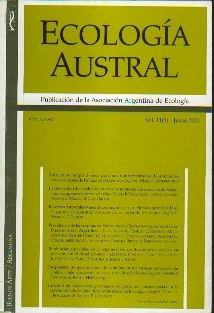Ver ítem
- xmlui.general.dspace_homeCentros Regionales y EEAsCentro Regional CórdobaEEA ManfrediArtículos científicosxmlui.ArtifactBrowser.ItemViewer.trail
- Inicio
- Centros Regionales y EEAs
- Centro Regional Córdoba
- EEA Manfredi
- Artículos científicos
- Ver ítem
Incidencia de fuegos en la Argentina durante las últimas dos décadas y su asociación con coberturas y usos del suelo en distintos contextos ambientales
Resumen
El uso del fuego ha impulsado grandes cambios en la cobertura de la tierra. Aunque la ocurrencia de fuegos está modulada por condiciones climáticas y por la disponibilidad de biomasa combustible, el ser humano ha modificado los regímenes históricos de fuego mediante diversos mecanismos. En muchos ambientes, las actividades antrópicas son las moduladoras principales del régimen moderno de fuego. En este estudio analizamos la incidencia de fuego en la
[ver mas...]
El uso del fuego ha impulsado grandes cambios en la cobertura de la tierra. Aunque la ocurrencia de fuegos está modulada por condiciones climáticas y por la disponibilidad de biomasa combustible, el ser humano ha modificado los regímenes históricos de fuego mediante diversos mecanismos. En muchos ambientes, las actividades antrópicas son las moduladoras principales del régimen moderno de fuego. En este estudio analizamos la incidencia de fuego en la Argentina entre 2000 y 2019. En particular, 1) caracterizamos la ocurrencia de fuego a nivel provincial y 2) evaluamos el patrón espacial de la superficie quemada (SQ); en las zonas donde se concentró la SQ, 3) describimos el clima y la vegetación, y 4) evaluamos si distintas coberturas/usos del suelo se asociaron con atributos del régimen moderno de fuego (frecuencia y extensión). Entre 2000 y 2019 se quemaron 47.84 Mha, que se concentraron en el centro-norte de la Argentina. En dicha área se diferenciaron cuatro zonas climáticas (subtropical-húmeda, subtropical, templada y templada-semiárida), seis unidades de vegetación (Chaqueña, Monte, Pampeana, Espinal, Yungas y Paranaense) y siete conglomerados de asociación espacial entre coberturas/usos de suelo y fuego. Los fuegos asociados al uso intensivo del suelo ocurrieron mayormente en las zonas subtropical y templada, con vegetación de las unidades Chaqueña y Espinal. Los relacionados con usos de baja intensidad se registraron sobre todo en las zonas subtropical-húmeda y templada semiárida, con vegetación de las unidades Monte y Paranaense. En la mayoría de los casos, el fuego se usó para disminuir o eliminar la cobertura de especies nativas, leñosas o herbáceas con el objetivo de promover el crecimiento de especies cultivadas (cereales, oleaginosas) o forrajeras (implantadas o autóctonas), para favorecer la producción agrícola o ganadera. Por lo tanto, los resultados sugieren que la elevada incidencia de fuego en el centro de la Argentina se asocia al sistema productivo actual.
[Cerrar]
Abstract. Fire incidence in Argentina during the past two decades, and their association with land cover and use in different environmental contexts. The use of fire has driven great changes in land cover. Although the occurrence of fires is modulated by climatic conditions and the availability of fuel biomass, human beings have modified historical fire regimes through various mechanisms. Therefore, in many environments, human activities are the main
[ver mas...]
Abstract. Fire incidence in Argentina during the past two decades, and their association with land cover and use in different environmental contexts. The use of fire has driven great changes in land cover. Although the occurrence of fires is modulated by climatic conditions and the availability of fuel biomass, human beings have modified historical fire regimes through various mechanisms. Therefore, in many environments, human activities are the main driver of the modern fire regime. In this study, we analyze fire incidence in the Argentine territory for the period 2000-2019. Specifically, we 1) characterize fire occurrence at the provincial level and 2) evaluate the spatial pattern of the burned area (BA); in the areas where BA was concentrated, we 3) describe environmental conditions (climate and vegetation) and 4) evaluate whether different land covers or uses were associated with certain characteristics of the modern fire regime (frequency and extent). Between 2000 and 2019, 47.84 Mha were burned, mainly concentrated in north-central Argentina. Within this area, we differentiated four climatic zones (wich were subtropical-humid, subtropical, temperate and temperate semiarid), six vegetation units (Chaco, Monte, Pampas, Espinal, Yungas, and Paraná), and seven conglomerates of spatial association between land cover/uses and fire incidence. Fires associated with high-intensity land use occurred mostly in the subtropical and temperate zones, with vegetation of Chaco and Espinal units. Those related to low-intensity land uses were registered mainly in subtropical-humid and temperate-semiarid zones, with vegetation of Monte and Paranaense units. In most cases, fire was used to reduce or eliminate the cover of native species, either woody or herbaceous vegetation units, to promote the growth of cultivated (cereals, oilseeds) or forage-species (implanted or native), to foster agricultural and/or livestock production, respectively. Therefore, our results suggest that the high incidence of fires in central Argentina was associated with the current productive system.
[Cerrar]

Autor
Cavallero, Laura;
Peinetti, Raúl;
Lopez, Dardo Ruben;
Fuente
Ecología Austral 33 (3) : 773-797. (diciembre 2023)
Fecha
2023-12-01
Editorial
Asociación Argentina de Ecología
ISSN
0327-5477
1667-782X
1667-782X
Documentos Relacionados
Formato
pdf
Tipo de documento
artículo
Proyectos
(ver más)
INTA/2023-PD-L02-I091, Adaptación a la variabilidad y al cambio global: herramientas para la gestión de riesgos, la reducción de impactos y el aumento de la resiliencia de socioecosistemas
INTA/2023-PD-L03-I095, Desarrollo y validación de un marco metodológico institucional para la evaluación de la sostenibilidad
INTA/2019-PE-E1-I514-001, Manejo de Bosques con Ganadería Integrada (MBGI)
Palabras Claves
Derechos de acceso
Abierto
 Excepto donde se diga explicitamente, este item se publica bajo la siguiente descripción: Creative Commons Attribution-NonCommercial-ShareAlike 2.5 Unported (CC BY-NC-SA 2.5)
Excepto donde se diga explicitamente, este item se publica bajo la siguiente descripción: Creative Commons Attribution-NonCommercial-ShareAlike 2.5 Unported (CC BY-NC-SA 2.5)


